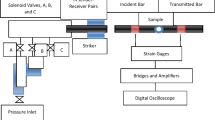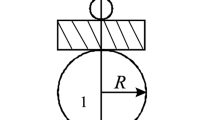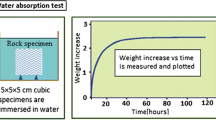Abstract
Rock strength affects the behaviour of rocks differently under different conditions such as temperature, time, pressure, presence of fluids, rock mass characteristics and stress history of rock in a natural environment. It is not always easy to replicate such conditions of undisturbed rock in a laboratory scale. Hence, it is imperative to study the rock behaviour with respect to every such condition which the rock experiences since its time of formation. Temperature is one of the key parameters which influence the rock throughout its history, ranging from the conditions of formation, experience of depth (loading/unloading) or deformational and metamorphic history. Also, increase in rock temperature; say due to the thermal stress changes like disposal of spent nuclear fuels affects the strength of the surrounding rock. In this work, the effects of temperature on the tensile strength of rock have been studied. The results obtained were interesting as the strength of rock is found to increase considerably up to a particular temperature after which it starts falling by as much as 70% around 250°C.






Similar content being viewed by others
References
ASTM (1988) Standard methods for splitting tensile strength of intact rock core specimens, D 3967-86. Annual book of ASTM standards, Soil Rock; Build Stones Geotext, pp 471–475
Bhattacharya S, Sen SK, Acharyya A (1994) The structural setting of the Chilka Lake granulites–migmatite–anorthosite suite with emphasis on the time relation of charnockites. Precamb Res 66:393–409
Biswal TK, Sinha S (2003) Deformation history of the NW salient of the Eastern Ghats Mobile Belt, India. J Asian Earth Sci 22:157–169
Chetty TRK (1995) A correlation of Proterozoic shear zones between Eastern Ghats, India and Enderby Land, East Antarctica. Geol Soc India Mem 34:205–220
Closmann PJ, Bradley WB (1979) The effect of temperature on tensile and compressive strengths and young’s modulus of oil shale. Soc Petrol Eng J 19(5):301–312
Dasgupta S (1995) Pressure–temperature evolutionary history of the Eastern Ghats Granulite province: recent advances and some thoughts. Geol Soc India Mem 34:101–110
Dwivedi RD, Goel RK, Prasad VVR, Sinha A (2008) Thermo mechanical properties of Indian and other granites. Int J Rock Mech Min Sci 45:303–315
Heuze FE (1983) High temperature mechanical, physical and thermal properties of granitic rocks—A Review. Geomech Abs 20:3–10
ISRM Commission on Testing Methods (1978) Suggested methods for determining the tensile strength of rock materials. Int J Rock Mech Min Sci Geomech Abs 15:99–103
Jaeger JC, Hoskins ER (1966) Rock failure under the confined Brazilian test. J Geophy Res 71(10):2651–2659
Lau JSO, Jackson R, Gorski B (1991) Effects of temperature and pressure on the mechanical properties of Lau du Bonnet grey granite. In: Proceedings of 32nd United States Symposium, Norman pp 313–323
Mohan A, Tripathi P, Motoyoshi Y (1997) Reaction history of sapphirine granulites and a decompressional P-T path in a granulite complex from the Eastern Ghats. Proc Indian Acad Sci (Earth Planet Sci) 106:115–129
Natarajan V, Nanda JK (1981) Large scale basin and dome structures in the high grade metamorphic near Vishakhapatnam, South India. J Geol Soc India 22:548–592
Ramakrishnan M, Nanda JK, Augustine PF (1998) Geological evolution of the Proterozoic Eastern Ghats Mobile Belt. Geol Surv India Spl Pub 44:1–21
Rickers K, Mezger K, Raith MM (2001) Evolution of the continental crust in the Proterozoic Eastern Ghats Belt, India and new constraints for Rodinia reconstruction: implications from Sm–Nd, Rb–SrandPb–Pb isotopes. Precamb Res 12:183–210
Singh TN, Sinha S, Singh VK (2007) Prediction of thermal conductivity of rock through physico—mechanical properties. Build Environ 42:146–155
Yasar E, Ranjith PG, Perera MSA (2010) Physico-mechanical behaviour of southern Melbourne sedimentary rocks. Int J Rock Mech Min Sci 47:481–487
Yavuz H, Demirdag S, Caran S (2010) Thermal effects on the physical properties of carbonate rocks. Int J Rock Mech Min Sci 47:94–103
Author information
Authors and Affiliations
Corresponding author
Rights and permissions
About this article
Cite this article
Vishal, V., Pradhan, S.P. & Singh, T.N. Tensile Strength of Rock Under Elevated Temperatures. Geotech Geol Eng 29, 1127–1133 (2011). https://doi.org/10.1007/s10706-011-9440-y
Received:
Accepted:
Published:
Issue Date:
DOI: https://doi.org/10.1007/s10706-011-9440-y




